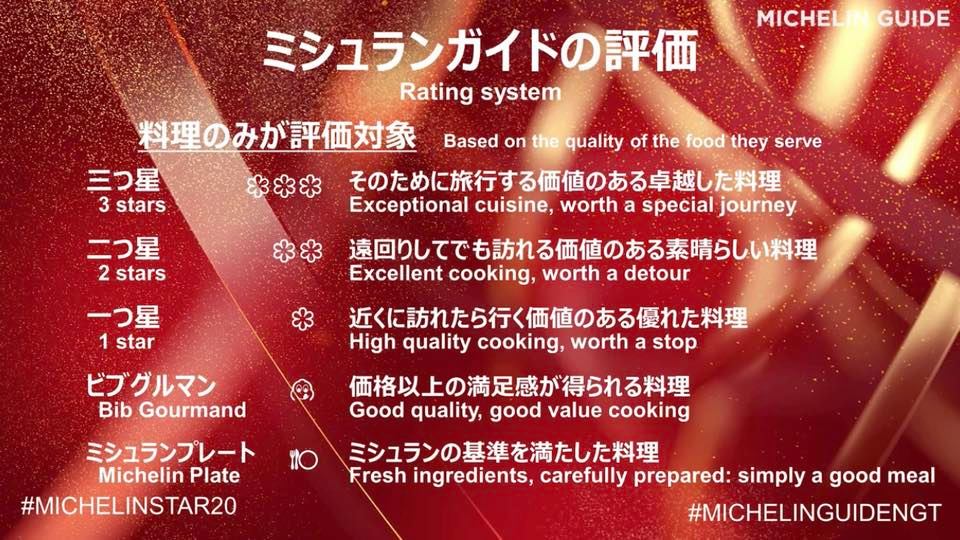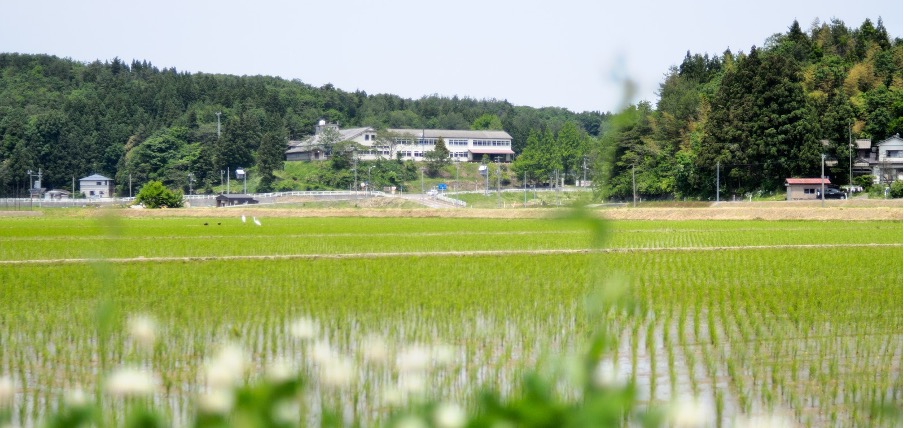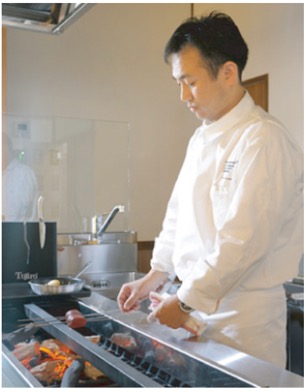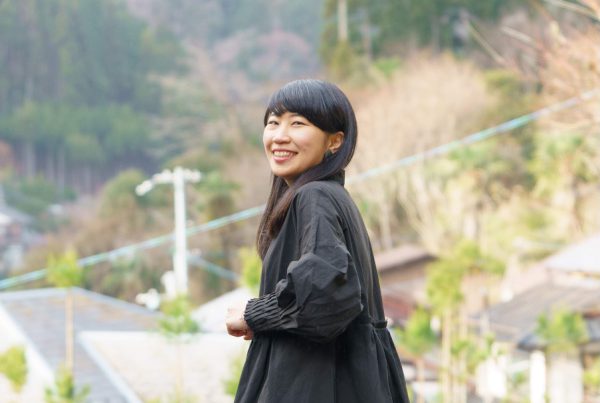Behind the mountains on a small hill, there is the chalk school building, catching the eye of all curious passersby. A stone staircase rises through the ground and the gymnasium gate, followed by a gentle slope and a rear scaffolding creating the perfect place for nature to meet human creation. In this place, the nostalgia and joy naturally come up with a relaxing view of Satoyama.
Shimada Elementary School was established on June 26, 1904, in Shimada-mura, Mishima-gun. Since then, it has been passed down and protected from generation to generation in the Wajima region for 105 years. The wooden school building and gymnasium were built in 1927 and closed with great sadness in March 2009 with the opening of Washima Elementary School.

Former Shimada Elementary School. Image via (和島トゥー・ル・モンド) Washima Tout Le Monde
The renovated 85-year-old wooden school building called Wajima tout le Monde is today a unique complex with a restaurant (Bague バーグ) and a bakery (Harmonie アルモニエ). WA in Wajima means “ all”, or “tout le monde” in French – something close to the concept of “inclusive togetherness”. The core idea is that different people of different generations feel the “power to live slowly” when they come together to this place. Wajima Tout le Monde is an authentic cuisine that is not bound by the format of French cuisine. The restaurant menu exhibits a cooking style that maximizes the characteristics of local ingredients. As a result, the menu is constantly changing, reflecting seasonal ingredients and harvest conditions.
Washima Tout Le Monde today. Image via (和島トゥー・ル・モンド) Washima Tout Le Monde
Souichi Nakazawa is a Bague Chef de Cuisine well known by many French-Japanese cuisine lovers. The Nagaoka Review team met him for an interview that immediately turned into a pleasant chat with a charismatic and hands-on gentleman, friendly and extrovert, as you would imagine his character should be – someone totally dedicated to his art.
”Our menu has the characteristics of using local ingredients. It is a cooking style that reflects the total originality of the seasonal ingredients and our harvest conditions. We provide fresh harvest "seasonal" that we have confirmed with our own eyes. We value the origin of local production for local consumption, which is kind and considerate to both customers and nature.
NR: Chef Nakazawa, can you please share some of your thoughts about Bague, how did you get involved, why did you think about French cuisine, and how did the idea of running a restaurant by making use of the old school building come about?
SN: In May 2012, under the guidance of the social welfare corporation Nagaoka Sanko Elderly Welfare Association, we started with the ideas of contributing to the creation of social value from the perspective of sustainable employment for the elderly and disabled people, and also the creation of economic value, in terms of creating jobs for everyone.
Wajima Tout Le Monde was founded in the Wajima area of the city of Nagaoka and has carried out employment support activities for persons with disabilities under the Comprehensive Support for Persons with Disabilities Act.
The story of this place is unique. One of my close friends told me to open a restaurant in this area to support people with disabilities through the restaurant business. At first, I was a bit worried about the idea, but, at the same time, I was very impressed by the concept and wanted to contribute too.
The reconstruction of the building began right away, and in July 2012, the Bague restaurant was opened. Since the opening, the vegetables used in Bague have been local produce by almost 100%.
”The producer makes our vegetables with the utmost care. Vegetables with plenty of umami speak the language of their creators and tell the stories of their journey into existence. An ingredient that makes you feel the will of the creator. I want to convey the joy and feelings of our customers through cooking.
Discovering Bague. Images via (和島トゥー・ル・モンド) Washima Tout Le Monde
After 12 years at a hotel and restaurant in Tokyo and 19 years of involvement in French cuisine, I returned to Niigata. I was thrilled when Bague was published in the Michelin Niigata Guide of July 2020. I will not forget that moment.
This is probably the first restaurant created with the assistance of people with disabilities in our area – this is how we support continued employment. It all started with a lot of collective courage and hopes that we would be evaluated in this way together, regardless of our differences.

Michelin Guide Niigata 2020. Image via (和島トゥー・ル・モンド) Washima Tout Le Monde
NR: What is the connection of the SDGs?
SN:I heard this from our farmers: although many of their products are raised correctly and are perfectly good for consumption, traditional buyers would not purchase them because of various product size issues. We find this one of the most significant food issues of our times – vegetables and fruit would not make it to national distributors simply because of their irregular sizes. There are many ways to use the irregularly sized product in modern cuisine.
We hope that restaurants can play a part in reducing food loss as much as possible and contribute to the problem of successors by connecting to the income of producers.
NR: How did the Nagaoka University of Technology raise the fish presented on the restaurant menu?
SN: On 9 and 10 December 2020 for two days, we held a collaboration event at Palace Hotel Omiya, where Chef Ketsuka Moezuka from Palace Hotel Omiya and Bague Chef de Cuisine Souichi Nakazawa offered a cooking course using ingredients from Niigata and Saitama. At that time, while looking for local ingredients, Hamaman Foods Co., Ltd. of Nagaoka City, a wholesale and processing maker of foods mainly for marine products, introduced a long tooth grouper, or “kue” in Japanese – that the Nagaoka University of Technology is growing on a trial basis. I tried it right away, and I found it an excellent quality fish, so I used it for our 9th-anniversary dinner.
We are not limited to the cities of Nagaoka and Izumozaki. Still, we face serious problems, such as the problem of successors in the fishing industry and fish resources. We are not limited to the cities of Nagaoka and Izumozaki. Still, we face serious issues, such as the problem of successors in the fishing industry and fish resources.
When I thought about what I could do as a restaurant so that Nagaoka University of Technology’s attempt could help our fishers, I decided to go there myself and talk to our fishermen and help them expand their awareness of alternative food production and their community networks.
NR: What is your future vision? Are there any new projects that you want to launch or get involved with?
SN: First, we want to create a place where our colleagues with disabilities can live independently – this is one of our core business purposes. To that end, we want to further raise the awareness of Bague within the region and at a national level and work together as a team so that our customers will be more delighted than ever, pleasantly surprise and feel at home here.
NR: Can you share with us your thoughts about the Nagaoka local community?
SN: In response to various social challenges, such as population decline in Nagaoka, as a restaurant, we are committed to discovering and introducing local resources, increasing customer appetite not only for our food, but also for our way of living, and promoting local consumption, while helping create a living habitat as attractive and inclusive as ever possible.
More information about Washima Tout Le Monde you can find here











